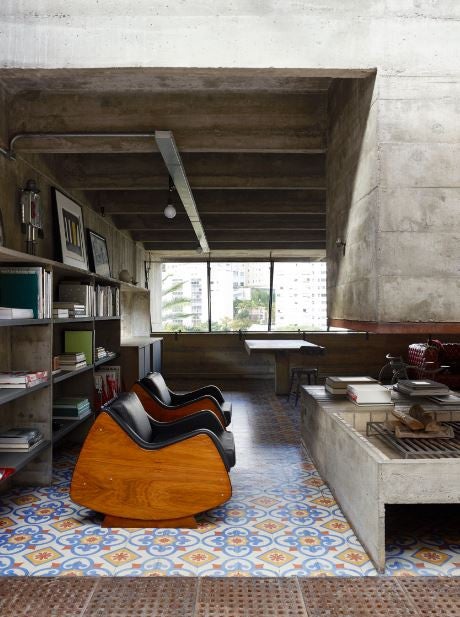The Must-Have Book Any Edgy Home Needs
'In the Rough' authors Iris De Feijter and Irene Schampaert dish on the joys of Brutalism and why the imperfect home is a happy one.
Published Sep 28, 2018 7:19 PM
We may earn revenue from the products available on this page and participate in affiliate programs.
The book takes into account the global rise of Brutalism in architecture and interior design, and it shares personal anecdotes of artisans, designers, and makers who choose to invest their lives in spaces and homes that disregard a flawless aesthetic. Instead, attention is paid to the imperfect moments that come to define home.
Through detailing the ways in which spaces are preserved, maintained, and transformed In the Rough takes a movement and uses it to connect separate corners of the world, from modernist homes located in Brazilian jungles to clock-making factories-turned-dwellings in Copenhagen.
We sat down with the authors to talk about the inspiration behind the book, learn how to channel imperfection in our own styles, and more.
The universal rise of brute—from Milan to Washington to São Paulo—makes the world feel smaller. What inspired you to curate these global spaces?
IDF and IS:
Even though Belgium has a strong tradition in brutalist architecture with architects such as Juliaan Lampens, we really wanted to make an international book. We wanted to show that this is a global trend. And we also wanted to show as many different versions of rough interiors as possible.
Some are rather refined, such as Arezzo, while others are totally rough and almost inhabitable, like the holiday house in Switzerland. It’s interesting to see how everyone finds his own roughness, defined by personality, climate, and taste.
Transformation and preservation have a strong dialogue in this book. The result is this sort of imperfect bricolage of design. What is the appeal of imperfection?
IDF and IS:
The appreciation of imperfection is inherent to human beings. We feel more at ease in a place that’s not perfect. We can just relate to it more easily, because we’re imperfect, too. Something perfect can have a really cold and distant feel about it, while textured surfaces invite you to touch and cherish. I think one’s house should be a place where one can find peace. And that’s easier in a warm and textured room that’s caressing you, rather than in a fridge-like house.
What makes brute design accessible?
IDF and IS:
It has a large do-it-yourself aspect to it. Rough materials can be really cheap, like timeworn wood, rusted metal, or decayed leather. You can find nice pieces in thrift shops and even in recycling centres. When you buy an old house, you can just peel off the wallpaper and leave the rough walls like that.
How can anyone furnish their home with elements of raw design?
IDF and IS:
Be creative and think out of the box. Use objects for something that they were not made for. You can turn an old pipe and a piece of wood into a coffee table. When you’re renovating a house, don’t throw away the parts that you’ve demolished, but save them. Maybe you can cover a wall with the former wooden floor, or make a new cupboard of old doors and windows.
Your book is filled with incredible texture and color. Is there a certain palette, person, or place that’s inspiring you right now?
IDF:
I’m really crazy about the work by Arno De Clercq, a young Belgian guy who just started his own brand. He’s also a collector/dealer of tribal art, and you really feel this heritage in his objects. During During Dutch Design Week this fall, I discovered the Formworks-series by Mieke Meyer that I also find very interesting. She builds moulds out of small pieces of plaster which gives it a concrete-like look. The forms are inspired also from Eindhoven I like ‘Adaptive Manufacturing’-series from Olivier Herpst & Sander Wassing: 3d-printed ceramic sculptures/vases that are based on natural logarithms.
What approach do you take when designing your personal homes?
IDF:
My boyfriend and I live in a neoclassical townhouse, built around 1880. We renovated it five years ago but kept the original ambiance and ornamented ceilings. I’m not at all a minimalist type of person when it comes to my house. I love going to flea markets; I’m a real collector, as is my boyfriend. I’m quite into color, so we’ve painted almost all our walls—pale pink, greyish green, dark blue, and chalkboard green.
Looking for more expert advice?
The Must-Have Home Accessory for Modern Boho Lovers My Scandinavian Home’s Niki Brantmark Reveals Her Secret to Balance The ‘Designer of the Decade’ Talks Inspiration and Aesthetics
Isn’t it time you got the news you actually want? Sign up for your daily Domino email here.
